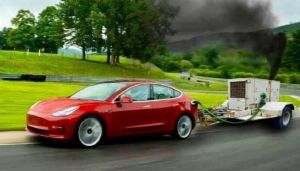Electric Vehicles
Plug-in electric cars, in most countries, are largely coal powered[1]. Thus, paradoxically, in the real world of today, petrol-powered cars produce fewer emissions than electric cars. Scientists at Oxford University recently modeled projected emissions from battery electric vehicles given different power generation mixes and concluded that if countries like India and China powered their automobilization booms with battery electric vehicles, this would be actually produce more CO2 emissions than if they did so with conventional petroleum- powered vehicles[2]. That's because coal is the dirtiest of fossil fuels, far dirtier than gasoline. But, according to the International Energy Agency (IEA), the share of coal used for global electricity generation is likely to grow. According to the IEA, in 2006, coal accounted for 41 percent of electricity generation fuel, natural gas 20 percent, hydropower 16 percent, nuclear 15 percent and 'other' (including renewables) 2 percent. By 2030, the IEA predicts that coal's share will rise to 44 percent of electricity generation, gas will account for 20 percent, hydropower 14 percent, nuclear 10 percent, with 'other' rising only to 9 percent[3]. And because oil is slated to run out long before coal, coal's share could rise further. So electricity generation is likely to remain a dirty business for a long time, and, indeed, the share of electricity generated by the dirtiest fuel, coal, is likely to increase.
Finally, if we turn to the actual production of electric vehicles, it turns out that this process is heavily polluting as well. That's because producing those nickel and lithium batteries, mining the iron and copper and rare earths that go into the motors and controls, not to mention the barely discussed problem of what to do with all the millions and eventually billions of large, toxic, worn-out batteries that have to end up somewhere, creates somewhat different resource consumption and pollution problems from those of gasoline and diesel engines, but by no means fewer problems[4]. For example, each of the 1 million Priuses that Toyota sells in the United States has a battery that contains 32 pounds of nickel. Just the production of that one car, at current rates, is said to consume fully 1 percent of all the world's annually produced nickel. And the mining and smelting of nickel is one of the most polluting of all industrial operations. Norilsk Nickel, a Russian company in northern Siberia, is the world's largest producer of nickel and largest smelter of heavy metals. According to WorstPolluted.org, Norilsk is the seventh-most- polluted industrial site on the planet. The city (founded as a slave labor camp under Stalin), where the snow is black, the air tastes of sulphur and the life expectancy of workers is 10 years less than the Russian average, is one of the most unhealthy places in an unhealthy country. Production at that plant has poisoned the soil for 60 kilometers around the plant. Local adults and children suffer from numerous respiratory diseases, cancer, etc[5]. A Norwegian government study reports that Norilsk's sulfur dioxide emissions (2 million tons a year) produce acid rain around the Arctic circle. The company also discharges large amounts of copper and nickel - as well as cobalt, vanadium and other metals - into freshwater lakes and streams. And much ends up in the Arctic Ocean[6]. And that's just the nickel. Lithium mining is another nightmare.[7] And then there's the 'rare earths' nightmare.[8]
References
- ↑ https://world-nuclear.org/nuclear-essentials/where-does-our-electricity-come-from.aspx
- ↑ Reed T. Doucette and Malcom D. McCulloch, 'Modeling the CO2 emissions from battery electric vehicles given the power generation mixes of different countries,' Energy Policy 39.2, February 2011, pp. 803-811.
- ↑ These figures are quoted in Robert Bryce, Power Hungry (New York: Public Affairs, 2010), p. 58 Figure 5.
- ↑ Don Sherman, 'When electric-car batteries die, where will they end up?' The New York Times, June 13, 2010.
- ↑ 'Top 10 Most Polluted Places, 2007.'
- ↑ 'To the Ministry of Finance, Recommendation of 16 February 2009' by the Council on Ethics, Norwegian Government Pension Fund (2009).
- ↑ See, for example, the excellent report by Dan McDougal: 'In search of Lithium: the battle for the third element,' Daily Mail Online (London) April 5, 2009 . Also, Damian Kahya, 'Bolivia holds key to electric car,' BBC News Online, November 9, 2008.
- ↑ Keith Bradsher, 'A new reckoning on costs of rare earths,' The New York Times, November 1, 2010; and idem, 'In China, illegal rare earth mines face crackdown,' The New York Times, December 29, 2010.
